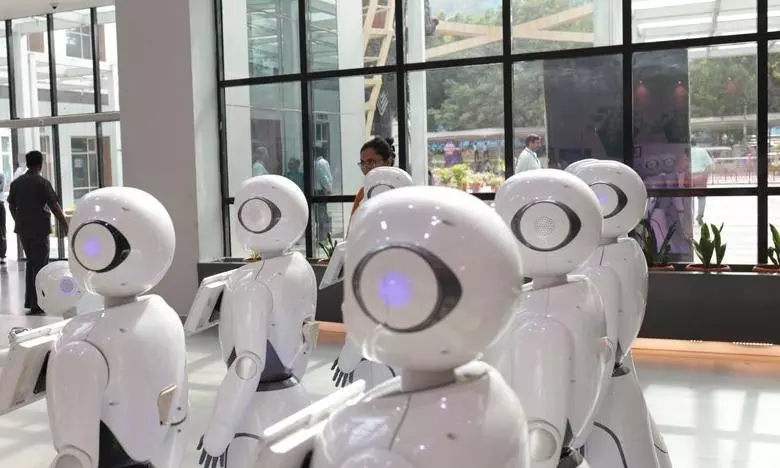
Kerala set to introduce robotics education for Class X students
29,000 robotic kits have already been distributed to high schools across the state to ensure seamless implementation

In a classroom-turned-makeshift computer lab in Kakkanad, Kochi, three ninth graders - Sagar Mohammed Sageer, Alisha Mathew, and Sayana Manohar - sat around a table, assembling a basic robot. They were attending a summer robotics camp organised by a local startup, working together to learn the fundamentals of building and programming.
All three are from Kochi but attend different types of schools. Sayana, a student at a state-aided school, will have robotics introduced as part of her regular curriculum next academic year. Alisha, who studies in an unaided school, is uncertain whether her school will implement the subject, although kits will be available for a fee. Sagar, who recently moved back from the UAE and is now in the CBSE stream, is considering shifting to the state syllabus after learning it includes AI and robotics.
Also Read: Chef, cheerleader, caregiver: A robot for your every need
“We just saw in the news that robotics will be introduced in Kerala schools,” said Alisha. “I’d definitely like to study it, but I’m not sure if my school will offer it.”
“I didn’t know the state syllabus had AI and robotics in the textbooks,” Sagar added. “It’s definitely something I’d be interested in.”
First state in India
For many students, this camp is their first experience with hands-on, technology-driven learning - something they now hope to see integrated into their regular classrooms. It will no longer be just a vacation activity - robotics is set to become a regular part of the school curriculum for Class 10 students in Kerala.
With Kerala becoming the first state in India to make robotics education mandatory for all 4.3 lakh Class 10 students starting June 2, 2025, the shift marks a significant step in the state’s approach to future-ready schooling.
Also Read: Robots on display capable of invasive surgery
This ambitious initiative, spearheaded by the Kerala Infrastructure and Technology for Education (KITE), integrates robotics into the 10th-grade Information and Communication Technology curriculum, marking a significant leap toward a tech-driven future for classroom learning.
Engaging, practical activities
The robotics module, embedded in the sixth chapter of the ICT textbook titled “The World of Robots”, introduces students to fundamental concepts through engaging, practical activities. According to K Anvar Sadath, CEO of KITE and Chairman of the ICT Textbook Committee, students will explore circuit construction, sensor and actuator utilisation, and computer programming to control electronic devices.
Also Read: AICTE approves courses in AI, robotics in colleges for 2021-2022
The curriculum’s first hands-on task challenges students to build an automated sanitiser dispenser using components from provided robotic kits, including Arduino breadboards, IR sensors, servo motors, and jumper wires. More advanced projects include designing AI-powered smart home automation systems, such as face-recognition-enabled smart doors, using the Pictoblocks software’s “Face Detection Built-in Model” and webcams on laptops.
29,000 robotic kits given to schools
KITE has distributed 29,000 robotic kits to high schools across the state to ensure seamless implementation. These kits, tailored for both government and aided schools, support the curriculum’s practical components. Additionally, KITE plans to provide extra kits to unaided schools following the state syllabus, ensuring inclusivity. The ICT textbook is available in Malayalam, English, Tamil, and Kannada, catering to Kerala’s linguistic diversity. To prepare educators, KITE has completed the first phase of training for 9,924 teachers on the new textbook, with dedicated robotics training scheduled for July 2025.
AI learning extended to Classes 8, 9, and 10
This initiative builds on Kerala’s earlier milestone of introducing AI education for all seventh-grade students, a national first achieved in the previous academic year. AI learning has now been extended to grades 8, 9, and 10, reinforcing the state’s commitment to future-ready skills. The robotics curriculum draws on practical insights from the “Little KITEs” programme, Kerala’s IT club for students, which piloted robotics education and shaped this comprehensive rollout.
“This is not just about teaching technology; it’s about empowering students to solve real-world problems through innovation,” Sadath said.
Also Read: The power of AI: Is there anything it can't do?
“The distribution of 29,000 robotic kits and the integration of AI into high school curricula has set a new benchmark for educational innovation,” said Dr TM Thomas Issac, former finance minister and central committee member of the CPI(M).
Equity in education
The curriculum aligns with broader trends in educational robotics, with the global market projected to reach $2.35 billion in 2025, driven by STEM adoption and coding literacy initiatives.
Teacher-training crucial
However, there are challenges. Some educators express concerns about the learning curve for teachers unfamiliar with robotics. KITE’s planned July training aims to address this, but sustained support will be crucial.
"Teacher-training camps were held last year, and many of us took part. However, most participants lacked the facilities needed for regular practice and updates. That’s why follow-up actions are crucial and essential”, says Sivaprasad Narayanan, a high school physics teacher from Ernakulam district.
Also Read: Andhra Pradesh entering AI-powered governance era, says CM Naidu
Students’ anticipation
For Sayana Manohar, who will be in class X this year, the prospect of building robots in the classroom is thrilling.
“I’ve always been curious about how machines work. This feels like a chance to create something real. That’s why I opted to skip a family vacation to be in this boot camp for robotics” she said.

